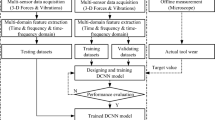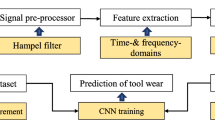Abstract
The tool is a component that is easily damaged and wasted in the CNC machining process. Accurate prediction of tool wear is conducive to reducing processing costs and improving processing efficiency. Most of the current research uses deep learning models to mine the degradation characteristics of tool wear. However, a single deep learning model and a simple sequential combination model can only learn some features, resulting in insufficient features extracted by the model, which seriously affects the accuracy of tool wear prediction. To solve the above problems, a tool wear prediction method based on parallel dual-channel adaptive features fusion is proposed. Firstly, the force, vibration, and acoustic emission signals collected by multi-sensors are preprocessed. Based on CNN-GRU and ConvGRU, a new dual-channel parallel structure is established to extract features from the input multi-sensor signal data. Secondly, the attention mechanism is used to fuse the features extracted from the parallel structure, and different weights are adaptively assigned to the tool wear features, thereby suppressing the influence of irrelevant or redundant features. Finally, the tool wear prediction values are output through the linear layer. The experimental results based on the PHM2010 data set show that the mean absolute error (MAE), root mean square error (RMSE), and coefficient of determination (R2) of the proposed method are 4.24, 6.41, and 0.966, respectively. The prediction performance of the model is better than other deep learning methods, which can accurately predict the wear state of the tool, provide information support for tool change decisions, and improve production efficiency.





























Similar content being viewed by others
Data availability
The acquisition website of these data sets is provided in this study.
Code availability
It declares that codes are not available for this research.
References
Kurada S, Bradley C (1997) A review of machine vision sensors for tool condition monitoring. Comput Ind 34(1):55–72. https://doi.org/10.1016/S0166-3615(96)00075-9
Najaf B, Hakim H (1992) A comparative study of non-parametric spectral estimators for application in machine vibration analysis. Mech Syst Signal Process 6(6):551–574. https://doi.org/10.1016/0888-3270(92)90049-O
Liu XL, Zhang B, Li XB, Liu XY, Yue CX, Liang SY (2022) An approach for tool wear prediction using customized DenseNet and GRU integrated model based on multi-sensor feature fusion. J Manuf Syst 34:885–902. https://doi.org/10.1007/s10845-022-01954-9
Wang DD, Liu QY, Wu DZ, Wang LQ (2022) Meta domain generalization for smart manufacturing: tool wear prediction with small data. J Manuf Syst 62:441–449. https://doi.org/10.1016/j.jmsy.2021.12.009
Yu JB, Cheng X, Lu L, Wu B (2021) A machine vision method for measurement of machining tool wear. Measurement 182:109683. https://doi.org/10.1016/j.measurement.2021.109683
Sawangsri W, Wattanasinbumrung P (2022) A model approach for in-process tool condition monitoring in CNC turning using machine vision. Int J Interact Des Manuf 16(4):1439–1456. https://doi.org/10.1007/s12008-022-01010-z
Dai YQ, Zhu KP (2018) A machine vision system for micro-milling tool condition monitoring. Precis Eng 52:183–191. https://doi.org/10.1016/j.precisioneng.2017.12.006
Yan BL, Zhu LD, Dun YC (2021) Tool wear monitoring of TC4 titanium alloy milling process based on multi-channel signal and time-dependent properties by using deep learning. J Manuf Syst 61:495–508. https://doi.org/10.1016/j.jmsy.2021.09.017
Yang Y, Zhao XF, Zhao L (2022) Research on asymmetrical edge tool wear prediction in milling TC4 titanium alloy using deep learning. Measurement 203:111814. https://doi.org/10.1016/j.measurement.2022.111814
Gomes MC, Brito LC, Silva MBD, Duarte MAV (2021) Tool wear monitoring in micromilling using Support Vector Machine with vibration and sound sensors. Precis Eng 67:137–151. https://doi.org/10.1016/j.precisioneng.2020.09.025
Xu LH, Huang CZ, Li CW, Wang J, Liu HL, Wang XD (2021) Estimation of tool wear and optimization of cutting parameters based on novel ANFIS-PSO method toward intelligent machining. J Intell Manuf 32:77–90. https://doi.org/10.1007/s10845-020-01559-0
Liang Y, Hu SS, Guo WS, Tang HQ (2022) Abrasive tool wear prediction based on an improved hybrid difference grey wolf algorithm for optimizing SVM. Measurement 187:110247. https://doi.org/10.1016/j.measurement.2021.110247
Kong DD, Chen YJ, Li N, Duan CQ, Lu LX, Chen DX (2019) Tool wear estimation in end milling of titanium alloy using NPE and a novel WOA-SVM mode. IEEE Trans Instrum Meas 69(7):5219–5232. https://doi.org/10.1109/TIM.2019.2952476
Nasir V, Sassani F (2021) A review on deep learning in machining and tool monitoring: methods, opportunities, and challenges. Int J Adv Manuf Technol 115(9–10):2683–2709. https://doi.org/10.1007/s00170-021-07325-7
Marani M, Zeinali M, Songmene V, Mechefske CK (2021) Tool wear prediction in high-speed turning of a steel alloy using long short-term memory modelling. Measurement 177:109329. https://doi.org/10.1016/j.measurement.2021.109329
Cai WL, Zhang WJ, Hu XF, Liu YC (2020) A hybrid information model based on long short-term memory network for tool condition monitoring. J Intell Manuf 31:1497–1510. https://doi.org/10.1007/s10845-019-01526-4
Guo H, Lin X, Zhu KP (2015) Pyramid LSTM network for tool condition monitoring. IEEE Trans Instrum Meas 71:1–11. https://doi.org/10.1109/TIM.2022.3173278
Zhang KF, Yuan HQ, Nie P (2015) A method for tool condition monitoring based on sensor fusion. J Intell Manuf 26:1011–1026. https://doi.org/10.1007/s10845-015-1112-y
Li YF, Wang XQ, He Y, Wang YL, Wang Y, Wang SL (2021) Deep spatial-temporal feature extraction and lightweight feature fusion for tool condition monitoring. IEEE Trans Ind Electron 69(7):7349–7359. https://doi.org/10.1109/TIE.2021.3102443
Huang ZW, Zhu JM, Lei JT, Li XR, Tian FQ (2020) Tool wear predicting based on multi-domain feature fusion by deep convolutional neural network in milling operations. J Intell Manuf 31:953–966. https://doi.org/10.1007/s10845-019-01488-7
Wang JJ, Yan JX, Li C, Gao RX, Zhao R (2019) Deep heterogeneous GRU model for predictive analytics in smart manufacturing: application to tool wear prediction. Comput Ind 111:1–14. https://doi.org/10.1016/j.compind.2019.06.001
Gao KP, Xu XX, Jiao SJ (2022) Measurement and prediction of wear volume of the tool in nonlinear degradation process based on multi-sensor information fusion. Eng Fail Anal 136:106164. https://doi.org/10.1016/j.engfailanal.2022.106164
Liu CF, Zhu LD (2020) A two-stage approach for predicting the remaining useful life of tools using bidirectional long short-term memory. Measurement 164:108029. https://doi.org/10.1016/j.measurement.2020.108029
An QL, Tao ZG, Xu XW, Mansori ME, Chen M (2020) A data-driven model for milling tool remaining useful life prediction with convolutional and stacked LSTM network. Measurement 154:107461. https://doi.org/10.1016/j.measurement.2019.107461
Li XW, Qin XJ, Wu JX, Yang JF, Huang ZX (2022) Tool wear prediction based on convolutional bidirectional LSTM model with improved particle swarm optimization. Int J Adv Manuf Technol 2022:1–15. https://doi.org/10.1007/s00170-022-10455-1
Zhao R, Yan RQ, Wang JJ, Mao KZ (2017) Learning to monitor machine health with convolutional bi-directional LSTM networks. Sensors 17(2):273. https://doi.org/10.3390/s17020273
Ma JY, Luo DC, Liao XP, Zhang XK, Huang Y, Lu J (2021) Tool wear mechanism and prediction in milling TC18 titanium alloy using deep learning. Measurement 173:108554. https://doi.org/10.1016/j.measurement.2020.108554
Cheng MG, Jiao L, Yan P, Jiang HS, Wang RB, Qiu TY, Wang XB (2022) Intelligent tool wear monitoring and multi-step prediction based on deep learning model. J Manuf Syst 62:286–300. https://doi.org/10.1016/j.jmsy.2021.12.002
Liu XL, Liu SY, Li XB, Zhang BW, Yue CX, Liang SY (2021) Intelligent tool wear monitoring based on parallel residual and stacked bidirectional long short-term memory network. J Manuf Syst 60:608–619. https://doi.org/10.1016/j.jmsy.2021.06.006
Xu XW, Tao ZR, Ming WW, An QL, Chen M (2020) Intelligent monitoring and diagnostics using a novel integrated model based on deep learning and multi-sensor feature fusion. Measurement 165:108086. https://doi.org/10.1016/j.measurement.2020.108086
Duan J, Zhang X, Shi TL (2023) A hybrid attention-based paralleled deep learning model for tool wear prediction. Expert Syst Appl 211:118548. https://doi.org/10.1016/j.eswa.2022.118548
Li ZX, Liu XH, Incecik A, Gupta MK, Krolczyk GM, Gardoni P (2022) A novel ensemble deep learning model for cutting tool wear monitoring using audio sensors. J Manuf Process 79:233–249. https://doi.org/10.1016/j.jmapro.2022.04.066
Kothuru A, Nooka SP, Liu R (2019) Application of deep visualization in CNN-based tool condition monitoring for end milling. Procedia Manuf 34:995–1004. https://doi.org/10.1016/j.promfg.2019.06.096
Luo ZW, Wang X, Wu X, Yin YB, Cao KL, Song Q, Hu AJ (2020) A spatiotemporal agent for robust multimodal registration. IEEE Access 8:75347–75358. https://doi.org/10.1109/ACCESS.2020.2989150
Li X, Lim BS, Zhou JH, Huang S, Phua SJ, Shaw KC, Er MJ (2009) Fuzzy neural network modelling for tool wear estimation in dry milling operation. Annual Conference of the PHM Society 2009 1(1):1–11. Retrieved from: https://papers.phmsociety.org/index.php/phmconf/article/view/1403.
Zhao R, Wang DZ, Yan RQ, Mo KZ, Shen F, Wang JJ (2017) Machine health monitoring using local feature-based gated recurrent unit networks. IEEE Trans Ind Electron 65(2):1539–1548. https://doi.org/10.1109/TIE.2017.2733438
Qiao HH, Wang TY, Wang P, Qiao SB, Zhang L (2018) A time-distributed spatiotemporal feature learning method for machine health monitoring with multi-sensor time series. Sensors 18(9):2932. https://doi.org/10.3390/s18092932
Wang H, Dong GM, Chen J (2021) Application of genetic programming in the identification of tool wear. Eng Comput 38(6):2900–2920. https://doi.org/10.1108/EC-08-2020-0470
Liu H, Liu ZY, Jia WQ, Lin XK, Zhang S (2020) A novel transformer-based neural network model for tool wear estimation. Meas Sci Technol 31(6):065106. https://doi.org/10.1088/1361-6501/ab7282
Liu H, Liu ZY, Jia WQ, Zhang DH, Wang QD, Tan JR (2021) Tool wear estimation using a CNN-transformer model with semi-supervised learning. Meas Sci Technol 32(12):125010. https://doi.org/10.1088/1361-6501/ac22ee
Peng YZ, Song QH, Wang RQ, Liu ZQ, Liu ZJ (2023) Intelligent recognition of tool wear in milling based on a single sensor signal. Int J Adv Manuf Technol 124(3–4):1077–1093. https://doi.org/10.1007/s00170-022-10404-y
Chan YW, Kang TC, Yang CT, Chang CH, Huang SM, Tsai YT (2022) Tool wear prediction using convolutional bidirectional LSTM networks. J Supercomput 78(1):810–832. https://doi.org/10.1007/s11227-021-03903-4
Zhang CD, Wang W, Li H (2022) Tool wear prediction method based on symmetrized dot pattern and multi-covariance Gaussian process regression. Measurement 189:110466. https://doi.org/10.1016/j.measurement.2021.110466
Funding
This study was supported by the National Natural Science Foundation of China (No. 51965006) and the Guangxi Key Laboratory of Manufacturing System & Advanced Manufacturing Technology (Grant No. 19–050-44-S006).
Author information
Authors and Affiliations
Contributions
Xianwang Li: supervision, project administration, funding acquisition, writing—review and editing. Jinfei Yang: methodology, experiment, software, writing—original draft. Jinxin Wu: validation, investigation. Xuejing Qin: data curation.
Corresponding author
Ethics declarations
Ethics approval
The authors claim that there are no ethical issues involved in this research.
Consent to participate
All the authors consent to participate in this research and contribute to the research.
Consent for publication
All the authors consent to publish the research. There are no potential copyrightagiarism issues involved in this research.
Competing interests
The authors declare no competing interests.
Additional information
Publisher's Note
Springer Nature remains neutral with regard to jurisdictional claims in published maps and institutional affiliations.
Rights and permissions
Springer Nature or its licensor (e.g. a society or other partner) holds exclusive rights to this article under a publishing agreement with the author(s) or other rightsholder(s); author self-archiving of the accepted manuscript version of this article is solely governed by the terms of such publishing agreement and applicable law.
About this article
Cite this article
Yang, J., Wu, J., Li, X. et al. Tool wear prediction based on parallel dual-channel adaptive feature fusion. Int J Adv Manuf Technol 128, 145–165 (2023). https://doi.org/10.1007/s00170-023-11832-0
Received:
Accepted:
Published:
Issue Date:
DOI: https://doi.org/10.1007/s00170-023-11832-0




